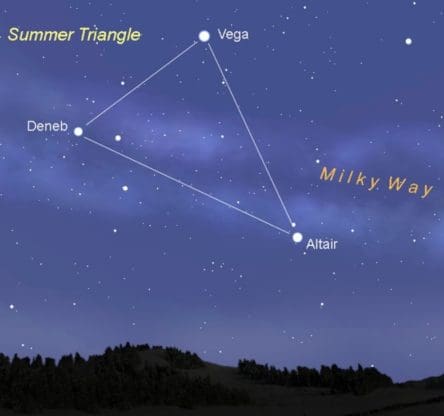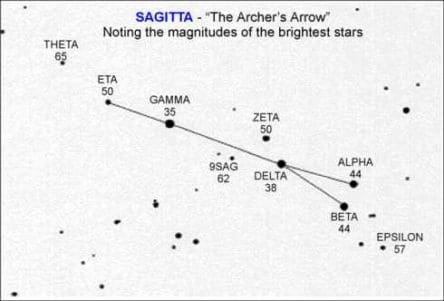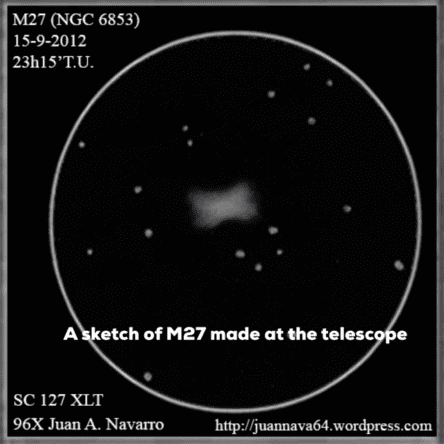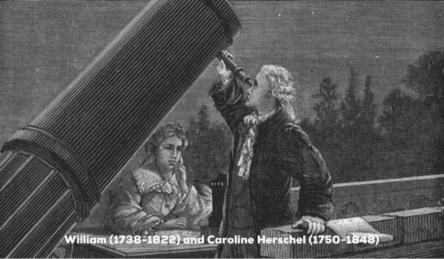September 2019 Feature – Messier 27: The Dumbbell Nebula

As we bid farewell to summer this month, I thought it might be a good idea to pay a visit to one of the season’s best deep sky objects while we still can, Messier 27, a.k.a., “The Dumbbell Nebula”.
FINDING M27

Locating this nebula can be a bit tricky, but once you find it, you should always be able to come back to it with little effort.
At this time of the year, M27 is overhead during the evening, lying within the dinky constellation of Vulpecula. What? You’ve never heard of Vulpecula? I’m not surprised as the stars that comprise it are ridiculously faint. Hunting down the fox is not going to help us here, instead we are going to go with a bigger, brighter star pattern: The Summer Triangle.
The Summer Triangle is an asterism, an informal star pattern, not one of the official constellations recognized by the International Astronomical Union. It’s comprised of 3 bright stars from 3 different constellations.
Go outside during the early evening hours and find the 3 brightest stars that are overhead. To the east, look for 1.25 magnitude Deneb, the brightest star in Cygnus the Swan, which lies within the Summer Milky Way. North of the Milky way, you will find the brightest star in the constellation Lyra (and the brightest star of the triangle), 0.03 magnitude Vega. West of the constellation Cygnus, and just south of the Milky Way, you will find Altair, the brightest star of Aquila the Eagle, shining at a magnitude of 0.77. To give you an idea of the size of the triangle, the distance between Deneb and Vega is about 20 degrees, that’s two fist widths held out at arm’s length. From Deneb to Altair is about 30 degrees.

Now we need to narrow our field of view down a bit more. Go to Altair and head roughly north a few degrees until you come to a grouping of 4 stars, none of which are brighter than 4th magnitude, and which form a pattern that looks like an arrow. In fact, this is Sagitta, the Arrow, the third smallest of all the constellations.

The stars Alpha, Beta, and Delta form a triangle, that represent the arrow’s feathers. Take the distance between the stars Gamma and Eta, go that same distance again north from Eta, and you are now in the constellation of Vulpecula.
With the aid of a star chart, find the 6th magnitude star 14 Vulpeculae. M27 is right below it. Alternatively, take those three stars that make up the arrow’s feathers. Remember how they formed a triangle? Well, let’s imagine that we take that triangle, turn it so that Alpha and Beta are sitting atop the arrow’s point (Eta) with Delta pointing North. Using Delta now as a pointer, M27 is just above and a little to the left of the point, about the same distance as the width that separates Alpha and Beta.

With a pair of 7X binoculars, M27 can be seen as a puffy point of light. With a telescope, start out with a low power eyepiece to initially find it and then switch to medium or, preferably, as high a power as your instrument will allow. In small telescopes, the nebula will look like an out of focus bow tie. With larger instruments and high-power eyepieces, the bi-lobed appearance of the nebula will become much more apparent. An Oxygen-III (OIII) light pollution filter will help bring out contrasts in the nebula. Since nebulas of this type contain a lot of doubly ionized oxygen (the atoms are missing two electrons), the OIII filter will only allow this particular pair of emission lines to reach your eye.
One final tip for observing this nebula and others of its type: use averted vision! Averted vision means that, rather than trying to look at the object in the center field of your vision, use your peripheral vision instead. Why? Because in the center of your eye, the fovea, there are mostly cone cells, the cells your eye uses for daytime vision. Rod cells, the cells your eye uses under low light conditions are found around the periphery of your eye. By making use of the rods in your peripheral vision, you can see objects 20-40x fainter than your center vision will allow.
WHAT YOU ARE SEEING

Messier 27 is a “planetary nebula”, but that name is something of a misnomer as it has nothing to do with planets. The name was coined by German-born, English astronomer William Herschel back in the 1780’s. Herschel had just recently discovered the planet Uranus (just one of his, and his sister Caroline’s, many accomplishments in the field of astronomy). He noted a kind of blue-green color to this peculiar category of nebulas that reminded him of Uranus, so he called them “planetary nebulas” and we have been stuck with the label ever since.


It was John Herschel, William’s son, who, in 1828, gave it the name “dumbbell”, by comparing its shape to the weight that’s used in your workout session. But it was French astronomer, Charles Messier, who discovered it on July 12, 1764. In fact, it was the first such planetary nebula ever discovered. He described the object as a “nebula without a star” and noted that it had an oval shape. Messier was first and foremost a comet hunter. To him, these odd bits of nebulosity were a hindrance to his goal of finding more and more comets. Whenever he stumbled upon one, he would have to devote several nights of precious observing time in order to figure out whether or not it was moving against the background stars the way a comet should. If it didn’t, then he had wasted time on it and, so, he decided to catalog all of the “comet impostors” he came across so that he could avoid them in the future. The Dumbbell Nebula was the 27th fake comet in his catalog.

Okay, it’s not a planet or a comet, so what is it? Well, what you are looking at in Messier 27 is the last dying gasps of a star that was once very much like our own Sun. Stars with the mass of the Sun have just enough hydrogen fuel within their cores to keep their nuclear furnaces going for about 10 billion years or so. The Sun has been happily converting 655 million tons of hydrogen into 650 million tons of helium every second of every day for the past 4.6 billion years. That missing 5 million tons of matter isn’t really missing at all, it’s converted into the light and energy that our planet relies upon for life to exist here on the good old Earth (just as Albert Einstein tells us in his famous equation of E = mc2).
But if there is one thing that the universe can teach us, it is that nothing lasts forever, not even the stars. At some point, that supply of hydrogen within the core will be used up, all of it converted into helium. At this point, a star faces an energy crunch. Throughout the star’s life, it has been fighting a battle with gravity. Gravity wants to crush the star down, but the star’s energy output has held gravity at bay. For most of its life, an uneasy equilibrium has existed between the star and gravity, but once the core can no longer stoke its nuclear furnace, gravity begins to win, and the core starts to contract. But this core contraction only serves to make it hotter, so hot in fact that a shell of hydrogen surrounding it begins to undergo fusion. Over a period of hundreds of centuries, the energy being radiated from the contracting core will cause the star’s outer layers to swell to monstrous proportions and the star enters into a phase known as a “red giant”.

Eventually, the star’s core gets so hot (like, 100 million Kelvin hot), that the helium inside it begins to fuse in a burst of energy that transforms the helium into carbon. Over the next few million years, the star’s outer layers swell even more, and the red giant phase continues apace as the star loses more and more mass via the ejection of gas and dust into space. Finally, with nothing left to fuse, the core becomes exposed as a hot, compressed, stellar corpse known as a “white dwarf”. The white dwarf is so hot (100,000 Kelvin) from having gravity compress it down to something the size of the Earth, that it begins to emit a powerful stellar wind that shoves all of the ejected gas and dust into a spherical bubble around it. By the way, the material inside a white dwarf is so dense, that a mere teaspoon of it would weigh over 5 tons, as much as a fully-grown elephant! The intense radiation from the white dwarf makes the gas glow for the next 40,000 years or so, and this ghostly glow is what we call a planetary nebula.
The Dumbbell Nebula is about 1,360 light years away from Earth (its distance has proven difficult to pin down with any certainty) and is about 1.44 light years across. It is one of the best and brightest of all planetary nebulas, with an apparent magnitude of 7.4 (the faintest star you can potentially see with the unaided eye is about magnitude 6 under good, dark sky observing conditions). It is only rivaled in brightness by the Helix Nebula in the constellation of Aquarius. However, the surface brightness (the apparent brightness of an extended object per unit area) of the Dumbbell is higher than that of the Helix, making the former much easier to find and observe.

The Dumbbell is also rather impressive in terms of its angular size. Its brighter center covers 8 by 5.6 arc minutes of sky while its faint halo extends out to 15 arc minutes (by comparison, the full moon has an angular size of about 30 arc minutes). The Ring Nebula (Messier 57), another popular planetary nebula for backyard stargazers, has an apparent magnitude of 8.8 and is 1.4 x 1.0 arc minutes in angular size.
Some planetary nebulae appear as simple bubbles while others, like M27, have a more complicated structure. We don’t yet have a handle on how some of these complex shapes occur. In some cases, the dying star seems to blow off its outer layers in simple, spherical bubbles, as if the dying star is just sitting there rotating slowly all by itself. In other cases that does not appear to be the case. Rather than being simple, glowing bubbles of gas, we find a diverse array of planetary nebulae shapes. Some are elongated spindles, some are hourglass shaped, some look like butterflies, while others look like barrels. How do we account for these shapes? Some of the dying stars that give birth to these kinds of nebulae may not have been alone, they might have had a binary companion. And that turns out to be the case with M27. The dying star blew off its gaseous outer layers in the plane of the orbit that it shared with its companion, the companion then helped eject the cast-off mass into the dual-lobed pattern we see. Still another possibility for weirdly shaped planetary nebulae is that the dying star had large planets that orbited close to the parent star. As the star bloated into a red giant it swallowed up these planets and this spun the star up by pulling in more mass into itself. Think of how a figure skater begins to spin really fast as she/he pulls their arms in close to their body. In physics, this is called “conservation of angular momentum” and the process works just as well for skaters as it does for stars.
Contemplating the impermanence of stars or people is a bit of a downer I guess but think of it this way: the universe has constantly been recycling itself since it began some 13.8 billion years ago and from out of the ashes of star death there can be new beginnings. Those cast-off shells of gas and dust may one day become recycled into new stars. Some of those stars may have planets and some of those planets may support a form of life that, just like you and me, can look out into the universe and enjoy its myriad potential for awe and wonder.
